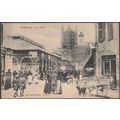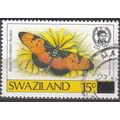Skomer Island, Pembrokeshire - Wick from Skomer Head - Judges postcard c.1970s
- Condition : Used
- Dispatch : 2 Days
- Brand : None
- ID# : 179888167
- Quantity : 1 item
- Views : 240
- Location : United Kingdom

- Seller : justthebook (+1703)
- Barcode : None
- Start : Fri 19 Apr 2019 11:50:34 (BST)
- Close : Run Until Sold
- Remain : Run Until Sold
More Listings from This Seller view all
Seller's Description
- Postcard
- Picture / Image: Skomer Island - The Wick from Skomer Head
- Publisher: Judges (C6909)
- Postally used: no
- Stamp: n/a
- Postmark(s): n/a
- Sent to: n/a
- Notes / condition:
Please ask if you need any other information and I will do the best I can to answer.
Image may be low res for illustrative purposes - if you need a higher definition image then please contact me and I may be able to send one. No cards have been trimmed (unless stated).
------------------------------------------------
Postage & Packing:
Postage and packing charge should be showing for your location (contact if not sure).
No additional charges for more than one postcard. You can buy as many postcards from me as you like and you will just pay the fee above once. Please wait for combined invoice. (If buying postcards with other things such as books, please contact or wait for invoice before paying).
Payment Methods:
UK - PayPal, Cheque (from UK bank) or postal order
Outside UK: PayPal ONLY (unless otherwise stated) please. NO non-UK currency checks or money orders (sorry).
NOTE: All postcards are sent in brand new stiffened envelopes which I have bought for the task. These are specially made to protect postcards and you may be able to re-use them. In addition there are other costs to sending so the above charge is not just for the stamp!
I will give a full refund if you are not fully satisfied with the postcard.
----------------------------------------------
Text from the free encyclopedia WIKIPEDIA may appear below to give a little background information (internal links may not work) :
*************
Skomer (Welsh: Ynys Sgomer) is an island off the coast of Pembrokeshire in west Wales. It is well known for its wildlife: around half the world's population of Manx shearwaters nest on the island, the Atlantic puffin colony is the largest in southern Britain, and the Skomer vole (a subspecies of the bank vole) is unique to the island. Skomer is a national nature reserve, a Site of Special Scientific Interest and a Special Protection Area. It is surrounded by a marine nature reserve and is managed by the Wildlife Trust of South and West Wales.
Skomer is known for its archeological interest: stone circles, standing stone and remains of prehistoric houses. Much of the island has been designated an ancient monument.
There is a hostel on the island so visitors can remain on Skomer after day trippers have taken the boat home.[1]
The island has an area of 2.92 km2 (720 acres).[2] Its highest point is 79 m (259 ft) above sea level at Gorse Hill, while the majority of the island sits at around 60 m (200 ft) above sea level. Skomer is intersected by a series of slopes and ridges giving it a rich and varied topography. It is approximately 2.4 km (1.5 mi) from north–south and 3.2 km (2.0 mi) east–west. The island is almost cut in two near its eastern side by two bays.[3][4] It is one of several islands lying within a kilometre of the Pembrokeshire coast and separated from the mainland by the treacherous waters of Jack Sound. A number of islets surround Skomer, the largest of which are: Midland Isle (height 50 metres, 164 feet), Mew Stone (60 metres, 197 feet) and Garland Stone (32 metres, 105 feet).[5]
Skomer is best known for its large breeding seabird population, including Manx shearwaters, guillemots, razorbills, great cormorants, black-legged kittiwakes, Atlantic puffins, European storm-petrels, common shags, Eurasian oystercatchers and gulls, as well as birds of prey including short-eared owls, common kestrels and peregrine falcons. The island is also home to grey seals, common toads, slow-worms, a breeding population of glow-worms and a variety of wildflowers. Harbour porpoisesoccur in the surrounding waters. The Skomer vole, a sub-species of bank vole, is endemic to the island.
There are around 10,000 breeding pairs of puffins on Skomer and Skokholm Islands, making them one of the most important puffin colonies in Britain. They arrive in mid-April to nest in burrows, many of which have been dug by the island's large rabbitpopulation. The last puffins leave the island by the second or third week in July. They feed mainly on small fish and sand eels; often puffins can be seen with up to a dozen small eels in their beaks. After a period of declining numbers between the 1950s and 1970s, the size of the colony is growing again at 1–2% a year (as of 2006). By 2004, there were numerous puffin burrows on the island and adults flying back with food run across the walkways oblivious to the tourists.
An estimated 310,000[9]:78 pairs of Manx shearwater breed on Skomer, with around 40,000 pairs on the "sister" island Skokholm. These colonies jointly comprise around half the world population and make the islands the world's most important breeding site for the species. The birds usually nest in rabbit burrows, a pair reportedly using the same burrow year after year.
Shearwaters are not easy to see as they come and go at dusk, but a closed-circuit television camera in one of the burrows allows subterranean nesting activity to be seen on the screen in Lockley Lodge on the mainland at Martin's Haven. The remains of shearwaters killed by the island's population of great black-backed gulls can also be seen. An overnight stay in the hostel run by the Wildlife Trust of South and West Wales allows guests to hear and see the shearwaters.
The Manx shearwater has a remarkable life. After fledging the young birds migrate to the South Atlantic off the coasts of Braziland Argentina. They remain there at sea for five years before returning to breed on their natal island. On their return they navigate back to within a few metres of the burrow in which they were born. As they are ungainly and vulnerable on the land, they leave their burrows at dawn for the fishing grounds some fifty kilometres north out in the Irish Sea, not returning until dusk. Thus they attempt to avoid the gulls to which they would fall easy prey.
Listing Information
| Listing Type | Gallery Listing |
| Listing ID# | 179888167 |
| Start Time | Fri 19 Apr 2019 11:50:34 (BST) |
| Close Time | Run Until Sold |
| Starting Bid | Fixed Price (no bidding) |
| Item Condition | Used |
| Bids | 0 |
| Views | 240 |
| Dispatch Time | 2 Days |
| Quantity | 1 |
| Location | United Kingdom |
| Auto Extend | No |



 for 1 item(s)
for 1 item(s)
















